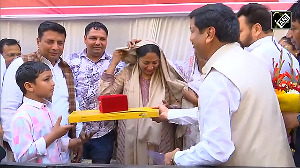 Mining need not be a dirty word. That's what the ministry of mines is trying to prove as it pushes through a revolutionary new concept which has responsible mining at its core.
Mining need not be a dirty word. That's what the ministry of mines is trying to prove as it pushes through a revolutionary new concept which has responsible mining at its core.
A new law has been put together to actually take control of the mining sector away from the government, specially the Union government, and make regulation by an independent authority the basis of mineral development in India.
Several factors have influenced the thinking behind the new Mines and Minerals Development and Regulation (MMDR) Act which will replace a 52-year-old law. One, mining controversies have become the norm today with widespread illegal and unscientific mining not only ruining the environment irreparably but also depriving states of revenue.
Another is the upsurge in Maoist violence in the mineral-rich forest areas of the country where exploitative mining practices and environmental degradation have alienated the local tribespeople. There is also the (slow) realisation that making local communities stakeholders in the mining industry can pay dividends.
The final draft was arrived at late in November and sent to the Cabinet recently after thrashing out problematic issues with different ministries and stakeholders. The biggest change that is envisaged is in the role of the government.
It will no longer control the sector but will regulate it through independent administrative and technical bodies and state tribunals. As such, the Union government will retain the power of prior approval only for coal and atomic minerals, deleting 10 other minerals from its purview.
States will now be fully responsible for managing the new concessions even if the Centre has retained specific powers to intervene in cases where there is contravention of the law.
(Ironically, the steel ministry has opposed the move on relinquishing control. It has been arguing that the central government is in a better position to decide how strategic minerals are to explored, produced and used, and has, therefore, been pressing for a tighter policy framework. If not, the power to grant licences for chrome, iron ore and manganese, the three minerals that hold the key to steel output, should be handed over to it.)
There are several aspects to the new regulations that would significantly alter the mining landscape of the country, such as auction of leases for new areas notified by the states and the seamless transfer of leases from prospecting to mining along with security of tenure for investors.
Although industry has raised a ruckus about the bidding, it is delighted with all other provisions, specially the seamless transfer, and the fact that decisions will be taken in a time-bound manner.
Although some environmentalists view the Sustainable Development Framework (SDF) with suspicion - it is the creation of the International Council on Mining and Metals (ICMM), a body promoted by the global mining behemoths - there is some acknowledgement by mining activists that proposals outlined by the ministry could help to address alienation of local communities and curb environmental degradation if properly implemented.
A major plus point is that SDF is integral to the new Act and any violations can be tackled under its provisions.
All the same, SDF will have its critics, not least because the seamless transition implies that the government would be bound to give mine leases even in ecologically sensitive areas.
However, the ministry says this will not be the case since environmental regulations will come into play.
Besides, several no-go areas are to be listed, specially in relation to water bodies. How far such safeguards will mesh with proposed grant of licences will be known only after the rules for implementing the Act are framed.
The ministry, however, is keen to show that it is serious about sustainability, which it believes is the best way to confront the evils of mining. Through a bidding process, it has already appointed the international consultants ERM to prepare the rules for implementing SDF and these are expected to be ready in four months.
SDF will work through the mining plan which is mandatory for companies involved in the extraction and development of all major minerals and will cover the entire area proposed to be leased out. Crucially, mine closure, a key environmental concern, will be part of the plan, which, for the first time, will be open to public scrutiny.
Mining secretary Santha Sheela Nair, who faced a lot of resistance on this score, promises that "there will be no need to invoke the Right to Information Act" for any disclosures everything will be in the public domain.
A National Mineral Fund, collected from a cess of up to 10 per cent of the royalty to be levied on major minerals, will help to meet the objectives of the SDF, both on the technology front and people-related issues.
Funds accruing to the Centre will be used to promoting scientific mining activities, including mine closures, and for beefing up the Indian Bureau of Mines to strengthen its enforcement role, while the monies going to the states are to be given to panchayats or gram sabhas to improve local infrastructure and equip the people with job skills.
In addition, mining companies are also expected to draw up a CSR document that will list the annual expenditure on local development programmes. While this sounds good on paper, there are several problem areas.
For starters, there is the question of getting community permission for mining. While the law states that institutions of local governance have to be made part of the consultation permission even before states notify the areas for prospecting or mining licences, there is no guarantee it will done in an open manner. The recent history of mining ventures is littered with violent controversies to prove the point.
Transparency continues to be a worry, says activist Ravi Rebbapragada of Samata, an organisation fighting for Adivasi rights. Although he is happy with some of the steps proposed by the ministry, such as the lowering of the threshold limit, which means companies have to undertake more scientific methods to extract more ore from a lease area, there are concerns about relief and rehabilitation (R&R) of the affected communities.
The ministry maintains that R&R will be central to SDF. People who have lost land as also the host population will be offered a package that includes an equity stake in the mining operations along with an annuity and/or jobs. Besides, at the end of the lease period, the land is to revert to the owners and to the state as at present.
Industry appears to have been persuaded that it in their best interests. The Federation of Indian Mineral Industries (FIMI) which groups the extraction and mineral-based industries, says it welcomes the SDF. As for the R&R package, FIMI says it is essential to give displaced people a stake in the industry, through jobs and equity, to ensure a peaceful working environment.
But how SDF pans out in its implementation, specially the efficacy of mine closure and post closure land use patterns, will determine whether sustainable mining continues to be an oxymoron.










 © 2025
© 2025